By Wil Deac
It was shortly before seven o’clock on the rain-drenched morning of April 27, 1945, the day before the death of Italian dictator Benito Mussolini. The hum of motors gradually displaced the serenity of the mountainous northern Italian countryside. A road convoy was rolling north on the two-lane highway less than 10 miles from the Swiss frontier on the northwest side of wishbone-shaped Lake Como. Crouching figures, one of them taking photos, watched from the rugged hillside as the vehicles entered a short tunnel just north of the hamlet of Musso. The 40-vehicle convoy was forced to an abrupt halt by a roadblock of rocks and a felled tree on the other side of the tunnel. Rifle fire erupted from the hillside. The armored car in the convoy barked a reply with its cannon.
A High-Profile Convoy
The occupants of the ambushed vehicles consisted of four components. There was a handful of armed Italians under Alessandro Pavolini, Fascist Italy’s propaganda minister. More numerous were two German units: a 40-man SS detail led by Lieutenant Fritz Birzer and a nearly 200-man antiaircraft detachment commanded by a Lieutenant Schallmayer (recorded as Fallmeyer in earlier accounts). However, it was the fourth element, entrusted to Birzer’s iron-handed care, that gave the column its historical significance.
Inside Pavolini’s armored car sat Benito Amilcare Andrea Mussolini, the 61-year-old Duce (Leader) of Fascist Italy. A sedan at the end of the convoy contained the dictator’s paramour, 33-year-old Claretta Petacci, and her brother, Marcello. Claretta, daughter of one of Pope Pius XI’s doctors, had abandoned her husband to become Mussolini’s lover for 13 years. Also in the column was a 21-year-old admirer of Il Duce, Elena Curti, daughter of another of Mussolini’s alleged mistresses. Her presence had earlier caused a stormy argument between the dictator and Claretta. All were fleeing the northward advance of American and British troops.
Their ambushers, alerted earlier of an approaching enemy convoy, belonged to the Italian 52nd Garabaldi Partisan Brigade under Count Pierluigi Bellini delle Stelle (pseudonym Pedro). The bearded and mustached partisan leader ordered a ceasefire. He and Luftwaffe Lieutenant Schallmayer then met under a flag of truce.
“I have orders to halt all enemy columns,” explained Bellini.
“And I,” replied Schallmayer in broken Italian, “have my orders to proceed.”
While the pair talked, Bellini’s deputy, Urbano Lazzaro, walked the length of the convoy. He counted an armored car, 10 cars, and 29 trucks occupied by an estimated 200 people. He discreetly informed his chief, confirming that their small band was both outnumbered and outgunned. The partisan commander decided to stall for time to bring in reinforcements and set up additional obstacles along the road ahead.
Schallmayer had no way of knowing that he was confronted with fewer than a dozen men. After nearly an hour of further discussion, the Italian said he could not permit the convoy to go on without the approval of his divisional commander. The bluff worked, if only because the Germans wanted merely to stay ahead of the Allies, not to fight. Who wanted to die when he knew that the war was nearly over? Schallmayer saw some of the 11 new roadblocks being put up when he was taken to the partisan headquarters at Dongo, about a mile north of Musso. During the next few hours, the Germans were allowed to remove the tree and debris blocking their way.
Bellini finally informed Schallmayer that the Germans could proceed under certain conditions. The key one was that all Italians and their vehicles would remain behind. It was close to 2 pm when the German rejoined the convoy to discuss the partisan terms with his officers and the Italians. They decided to accept Bellini’s demands with one exception—Mussolini would be disguised and go on with the Germans.
“The Dictator’s Spirit was Dead”
With apparent reluctance, a tearful Claretta at his side, Italy’s onetime dictator slipped into a Luftwaffe coat and placed a helmet on his bald head. Il Duce then climbed into the rear of the third German truck, seating himself between two large fuel containers. With him went two large leather cases of documents and five suitcases of currency and gold.
Motors churned into life, gears meshed, and the German vehicles started north toward a checkpoint established at Dongo. Behind them, the abandoned Fascists, fearing the worst from the partisans, reacted in different desperate ways. Some tried to turn their cars around. Others dove into chilly Lake Como to hide or swim away. A few were shot, but most were quickly rounded up. Pavolini was one of those wounded.
Meanwhile, the German column was halted in Dongo’s main square. The partisans checked documents and vehicles. It was not long before they came upon the gaunt shape slumped in the rear of the third truck. He’s just a drunken comrade, explained a German officer. Called over, Urbano Lazzaro was not fooled. He shook the slouching figure and, perhaps reflexively giving in to polite form of address, said, “Cavaliere [Excellency] Benito Mussolini.”
Il Duce, pale and exhausted, his jutting chin covered with stubble, arose and climbed out. “The dictator’s spirit was dead,” Lazzaro later recalled. “He was no longer of the living.”
Mussolini was told that he was being arrested “in the name of the Italian people” and would be safe as long as he offered no resistance. Surrounded by partisans, he walked slowly across the square to its town hall. A growing crowd, informed of the capture, applauded loudly. While Mussolini’s captors confiscated the two cases of documents, they left the others filled with currency and gold aboard the German convoy, which continued on its way.
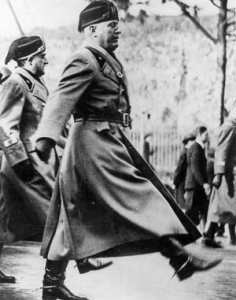
The partisans informed their regional headquarters of the Comitato di Liberazione Nazioriale (CLN, National Liberation Committee set up to coordinate anti-Fascist activities) of the capture of Mussolini and most of his ministers. The CLN was asked what it wanted done with the prisoners. Bellini strongly believed that Il Duce should be held for trial by the Italian authorities, not the Allies. He did not seem to realize that, as a widely dispersed organization comprised of local committees representing all sorts of groups, the CLN was not geared to make a quick, acceptable-to-all decision. Only one group knew precisely what it wanted—the Communists.
While awaiting word from the CLN in Milan, Bellini decided to move his prisoner to a more secure place, where the Germans, Fascists, Allies, or more radical partisans could not snatch him. Mussolini, his uniform replaced by a mechanic’s overalls, was driven westward in the relentless rain along the climbing, winding road from Dongo to Germasino. He arrived there shortly before 7 pm, almost exactly 12 hours after his convoy was intercepted. There, only four miles from neutral Switzerland, he was housed in the Guardia di Finanza (Customs) barracks. Il Duce shared his captors’ expectation of a trial. “I shall have much to say at the tribunal and I will show that in these 18 months I saved Italy from worse disasters,” he told a Guardia sergeant.
From a Poor Blacksmith’s Son to a Dictator
Whatever awaited him, it was a far cry from the future Mussolini had envisioned for himself and his country when he assumed dictatorial power in 1925. Il Duce had followed a torturous political path before his ascent to power. He was born the son of a poor blacksmith on July 29, 1883, in the hamlet of Dovia just below the administrative center of Predappio in the northeastern foothills of the Apennines. A feisty youth, he went on to become a socialist journalist and propagandist. The socialists expelled him for going against the party line and calling for Italy’s entry into World War I.
Swinging to the other side of the political pendulum, he established a blackshirted nationalist revolutionary group called the Fasci di Combattimento (Fighting Leagues) in 1919. His charisma and oratory skills got him elected to parliament two years later as leader of the National Fascist Party. In 1922, Italy was beset by political, economic, and social turmoil. Feeding off this unrest and threatening a “march on Rome” to take over, Mussolini maneuvered himself into being asked to form a government. He became Italy’s youngest prime minister, at 39, on October 29, 1922.
A major setback caused by the murder of popular socialist parliamentarian Giacomo Matteotti by Fascist goons in 1924 proved temporary. In enhancing his image, Mussolini became the first 20th-century politician to exploit modern communication techniques. A dictatorship soon was established, banning opposition newspapers and parties, and setting up a so-called corporate state, all with the backing of big business, the military, and the church. The strutting lantern-jawed dictator gave rise to such expressions as “Mussolini is always right” and “He made the trains run on time.” Political repression was tempered by extensive public works programs.
Mussolini’s Mare Nostrum
Overseas, Mussolini tried to reestablish the glory of ancient Rome so that the Mediterranean Sea could become mare nostrum (our sea). In 1935, he ordered the invasion and annexation of Ethiopia. The following year, overcoming his earlier aversion to Adolf Hitler, he signed a treaty creating an alliance with Nazi Germany. He subsequently reinforced this with the Pact of Steel, committing Italy to side with Germany in case of war. In all, and to his later regret, Mussolini had 17 meetings with Hitler. Both dictators helped assure Francisco Franco’s victory during the Spanish Civil War. Next on the Italian agenda was Albania, on the other side of the Adriatic Sea; it was invaded on Good Friday 1939 and annexed. (Read more about the events that led to the greatest war in history inside Military Heritage magazine.)
Mussolini’s military bubble burst with Italy’s entry into World War II. Recognizing the nation’s lack of preparedness, the opportunistic Duce hoped to ride on the coattails of German victories and share the spoils of war with minimum risk. As he told Marshal Pietro Badoglio, his chief of the supreme general staff, “I need several thousand dead to be able to take my place at the peace table.”
The results were predictable; the Fascist lion that roared turned out to be a shabby tabby. Mussolini waited until the French had just about succumbed to the German blitzkrieg in June 1940 before invading southeastern France. The Italians were bloodied. Italy also suffered defeats in East Africa, North Africa, and Greece. Hitler had to come to Mussolini’s rescue to the detriment of his own projected invasion of the Soviet Union.
A Dictator on the Run: Mussolini’s Escape from Campo Imperatore
Il Duce’s house of cards finally tumbled after the 1943 Allied invasion of his country. Timid King Victor Emmanuel III, who had agreed to Mussolini’s 1920s takeover, dismissed the dictator “after long hesitation and in some fear” and had him imprisoned in Campo Imperatore Hotel, a ski lodge in the Apennines northwest of Rome. Once again Hitler came to the rescue. Four days after the new Italian government under Marshal Badoglio proclaimed an armistice on September 8, 1943, 90 German glider troops led by SS Captain Otto Skorzeny landed on a rock-littered meadow beside the isolated lodge.
They quickly freed the hapless Mussolini and bundled him into a tiny Fieseler Storch observation plane. The high-winged aircraft wobbled over the rough ground and dropped off the 6,500-foot plateau. It slowly nosed up in the thin air and carried Skorzeny and his prize to Rome. Mussolini went on to Germany to be told what to do by his protector.
A physically and mentally depleted Mussolini was set up as the powerless head of a Republica Sociale Italiana. His puppet regime, monitored by German watchdogs, was subsequently established at Salo in northern Italy. The move was a last-ditch effort to “legitimize the German occupation of Italy and demonstrate the continuity of the Nazi-Fascist alliance.” The wartorn country obviously was in a chaotic state as the Allies gradually shoved the Germans back up the Italian peninsula. A national government of soldiers and technocrats operated under tight American and British oversight to the south.
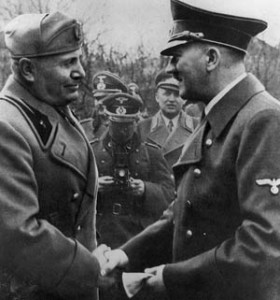
In the north, in addition to the Salo Republic, a rebellion coordinated by the CLN was resisting both the Axis and, with few exceptions, the royalty-tainted Badoglio government.
In April 1945, feebly asserting what independence he had left, Mussolini moved his capital first westward to Milan and then north to Como at the lower end of the tourist-attracting lake. Il Duce had regressed from a popular, high-profile public figure to a mere shadow, his bombastic bravado generally reduced to pessimism, resignation, and self-pity.
To one German he said, “Death has become a friend who no longer frightens me. Death is a gift from God to those who have suffered too much.” On April 14, the onetime dictator had his last formal meeting with the Germans, whom he blamed for his fall and now sought to discard in hope that a compromise accommodation could be reached with the CLN. The Allies had already refused to enter into negotiations, which the desperate Duce tried to initiate behind the Germans’ backs. Mussolini soon heard that the Nazis in Italy were trying to do the same thing behind Hitler’s back.
Just before leaving the prefecture at Como on his final journey, Mussolini penned a letter to his wife, Rachele, who had just arrived at a villa near the town. In it he asked “forgiveness for all the harm I have unwittingly done you. But you know that you are the only woman I have ever really loved.” He signed it, “Your Benito.” Distraught, she made several attempts to phone him. When they finally connected, she urged him to “flee to safety.” He calmly told her, “I see that all is over.” He did not want to leave Italian soil.
During the last days of Il Duce’s reign, Rachele and their children seemed always to be one town behind him. The couple had three boys and two girls. Mussolini, a notorious womanizer, also had at least one illegitimate child. Unlike his family, his mistress remained close by his side. She maintained that her “destiny was irrevocably linked with his.”
Mussolini left Como during the dark morning hours of April 26 with a small group, including his German babysitter, Lieutenant Birzer. They drove northward only a few miles to Menaggio. There Il Duce was joined by the Italians, including the Petaccis, who would accompany him on the final leg of his journey. Lieutenant Schallmayer’s Luftwaffe unit arrived as well to become part of the group of evacuees. The day was one of wasted movement caused by the confusion and indecision of frightened men. They finally settled down to spend the night in the lakeside town’s militia barracks. Waking early, Mussolini and his entourage set out before dawn. It was not long before their convoy ran into the partisan roadblock, ironically between Musso and Dongo.
“I Have Come to Shoot Them”
Count Bellini, apparently fearing that the Germasino site was still not secure enough for his well-known prisoner, decided on another move. Awakened during the night, Mussolini was disguised with bandages to pose as a wounded partisan. He was driven in a chilling rain back to Dongo. There he rejoined his lover. Traveling in two cars, the couple and their captors motored back toward Como. However, they never reached their destination, a secluded house two miles northeast of Como on the opposite side of the more than 30-mile-long lake. Distant gunfire stopped them. They learned that Allied troops were fighting diehard Fascists in Como.
The vehicles did a 180-degree turn and drove 10 miles to near Azzano on the lakeshore. Tired and sopping wet from the continuing rain, the small party made its way up the rugged foothills for about 15 minutes. They had to pause once so that Petacci, wearing high heels, a fur coat, and toting two large bags, could rest. At about 3 am, they reached the two-story home of a farmer known to the partisans. While the two prisoners slept, their fate was being debated by the CLN in liberated Milan.
Accounts differ, but it has been established that the Communists on the committee, acting on the orders of party secretary Palmiro Togliatti (who also was vice premier in the new Italian government), were determined to immediately execute Mussolini. Concealing their intent as much as possible from their less-radical colleagues, they persuaded the CLN to let one of their number bring the captives back to Milan. The man designated was Walter Audisio, a veteran of the Spanish Civil War’s International Brigades who used the pseudonym Colonel Valerio.
By the morning of Saturday, April 28, the storm had given way to dazzling sunlight. Audisio, his travels eased by a pass signed by the American liaison officer assigned to the CLN, pursued his single-minded mission accompanied by a fellow Communist, Aldo Lampredi, and a partisan escort. They followed Mussolini’s earlier route to Dongo via Como. Arriving at about 2 pm, they were received with anything but open arms.
Bellini insisted that the 52nd Brigade should have the honor of taking the captive to Milan. An argument ensued until Audisio blurted, “I have come to shoot them.” The Communist, stressing the fact that he was Bellini’s superior in the partisan movement, claimed that he was carrying out the CLN’s orders. Bellini slowly gave ground, suggesting that all the Fascist prisoners be gathered in Dongo to be formally turned over to Audisio. The latter, with Lampredi and two Communist partisans, left to get Mussolini and Petacci. Bellini went to fetch the other captives.
How Benito Mussolini Died
In the meantime, Il Duce and his mistress had risen late. At noon, given a lunch of polenta in their upstairs bedroom, Mussolini told Petacci that he had lost his appetite; suspense over their fate was getting to him. The waiting ended at about 4 pm. Audisio, wearing a brown raincoat and waving a submachine gun, burst into the room.
“Come quickly,” the intruder snapped. “I’ve come to free you.” The couple was hurried back down the hillside to the road. They were placed in the rear of a waiting black Fiat 1100. Audisio perched himself on a fender, while two partisans mounted the running boards. The other men, including two who had been guarding the farmhouse, squeezed into the sedan with the prisoners and the driver. They sped off. It was a short drive, perhaps a mile, ending just outside the hamlet of San Guilino di Mezzegra on Via XXIV Maggio (May 24 Road, named after the day in 1915 when Italian armies entered World War I).
Mussolini and Petacci, still in her ridiculously high heels, walked to the nearby iron-grilled gate of the Villa Belmonte, a large house on Lake Como protected by a low stone wall backed by high hedges. Audisio tried the gate. It was locked. Lampredi and one of the partisans were instructed to stand guard several yards on either side of the gate. The prisoners stood, backs to the wall, just to the left of the entrance. Their appointed executioner said, “By general headquarters of the Corpo Volontari della Liberta [Corps of Volunteers of Liberty, the CLN’s military arm] I am charged with rendering justice for the Italian people.”
The inhabitants of the villa were gazing out over the sunlit lake while listening to the radio when, they later said, they heard a woman cry out, “You’re not going to kill us just like that?” Running outside to see what was going on, they were shooed back into the house.
Meanwhile, Audisio pulled the trigger of his submachine gun. It jammed. He yelled to one of the partisans, who dashed halfway to meet him and exchange weapons. A short burst from the French-made MAS in Audisio’s hands punched into Petacci, tearing her from her lover’s grasp.
“Shoot me in the chest,” Mussolini said as he pulled back the lapels of his jacket. The Communist obliged. It was all over: Benito Mussolini was dead by about 4:20 pm. The two men who had been posted at the farmhouse were told to guard the bodies until they were picked up. The others climbed into the Fiat to return to Dongo. There, Audisio announced to Bellini that “justice is done. Mussolini is dead.”
Disposing of Il Duce
Audisio still was not done. Fifteen of the other captured Fascists, including Pavolini, but most arbitrarily selected by Mussolini’s killer, were lined up in the town square and summarily executed. Then Marcello Petacci, Claretta’s brother, was added to the pile.
Having by now taken complete control, Audisio had the dead men placed on sheets and loaded into a big yellow truck. At 6:15 pm, the vehicle left for Azzano, where it was met by a car bearing the bodies of Mussolini and his mistress. The two were transferred to the truck. It was not until close to 3 am on Sunday, April 29, that the 18 stiffening corpses were off-loaded at a garage under construction on Milan’s Piazzale Loreto. In August 1944, 15 partisans had been executed in that small square for shooting two German soldiers.
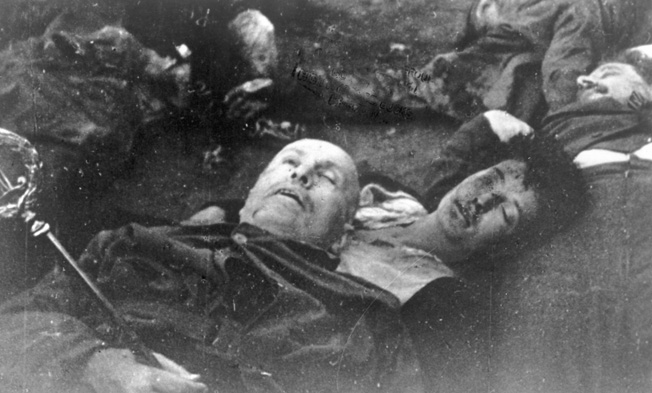
The macabre scene later that morning was a much-photographed one—frenzied, jeering crowds, who only four months earlier had cheered their Duce, milling beneath the bloody cadavers of Mussolini, Petacci, and four other Fascists hanging head down from a metal beam. To the bodies under them was added that of Achille Starace, the early Fascist Party secretary, who had been caught and shot on the spot. Someone took the time to bunch up Petacci’s skirt and secure it just above the knees. The corpses, mutilated and barely recognizable, were taken away that evening, placed in simple coffins, and displayed outside the city morgue.
Mussolini was secretly buried in a Milan cemetery. His remains were there only until 1946, when they were stolen by neo-Fascists and taken to a Franciscan monastery south of the city. Recovered by the authorities, they were moved again, this time to the Capuchin monastery at Cerro Maggiore northwest of Milan. Only in 1957 were the remains of Mussolini released to the family to be ultimately interred in the family crypt at Predappio.
The Fate of the Mussolini Name
Mussolini’s widow, Rachele, ever the devoted wife and mother, spent most of the postwar years on her farm at Predappio. She died there in 1979, at age 87, and was buried next to the one-time dictator and two of their children. Son Bruno had died testing an air force bomber in 1941; daughter Anna Maria, satisfied to be a housewife, passed on in 1968. Edda, the eldest and favorite of her father, an “independent-minded woman when women in Italy had few rights,” died of cardiac arrest in Rome in 1995. After the execution of her husband, Count Galeazzo Ciano, for treason in 1944 (his had been one of the cabinet votes to depose Il Duce), she disavowed her father and the family name. Vittorio, an airman, war veteran, and probably Mussolini’s most loyal child, died of kidney failure in Rome in 1997. Only Romano, who, to his father’s disappointment, became a highly successful jazz musician, lived to see the new century.
Walter Audisio served as a Communist deputy in the postwar parliament. He succumbed to heart failure in Rome in October 1973. Of the act that assured him a place in history, he once said, “I did not have the impression I was shooting a man, but an inferior beast.” His partisan counterpart, Bellini, passed on in Milan in January 1984.
The Mussolini name has made the newspapers innumerable times since that fateful Saturday in 1945, most recently in 2003. Alessandra Mussolini, Il Duce’s 40-year-old granddaughter, severed her ties to the rightist post-Fascist National Alliance Party for denouncing the one-time dictator’s 20-year reign as “shameful pages of history.” The daughter of Romano Mussolini, she had been a member of the Italian parliament for 11 years. Earlier, when she was nearly elected mayor of Naples with 44 percent of the vote, she said, “This is a victory for my grandfather.” Before that, she had abandoned an acting career after posing for Playboy magazine and unsuccessfully auditioning for the female lead in Big Top Pee-Wee, an American film. Her mother’s sister is the famous actress Sophia Loren.
Thus, the heritage of Benito Mussolini evolves and lives, a subject of ongoing fascination in Italy. Whether reviled or lauded, he remains the Fascist dictator who led an unprepared nation into World War II and died an ignominious death. Winston Churchill called Il Duce’s execution “murder,” but, looking at the other side of the coin, he realized, “at least the world was spared an Italian Nuremberg.”
Frequent contributor Wil Deac writes from his home in Washington, D.C. He is an expert on espionage and covert operations during World War II.
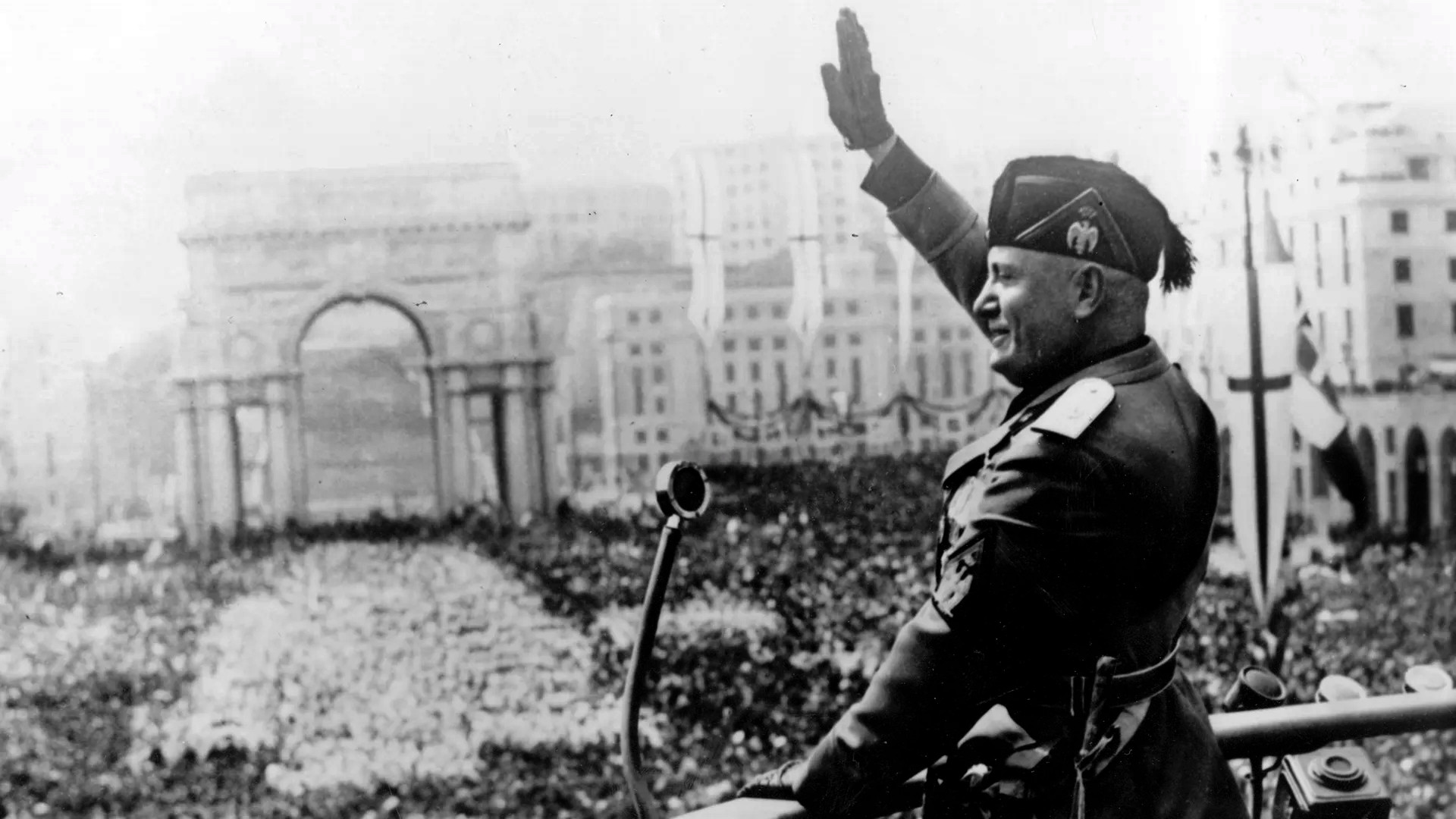
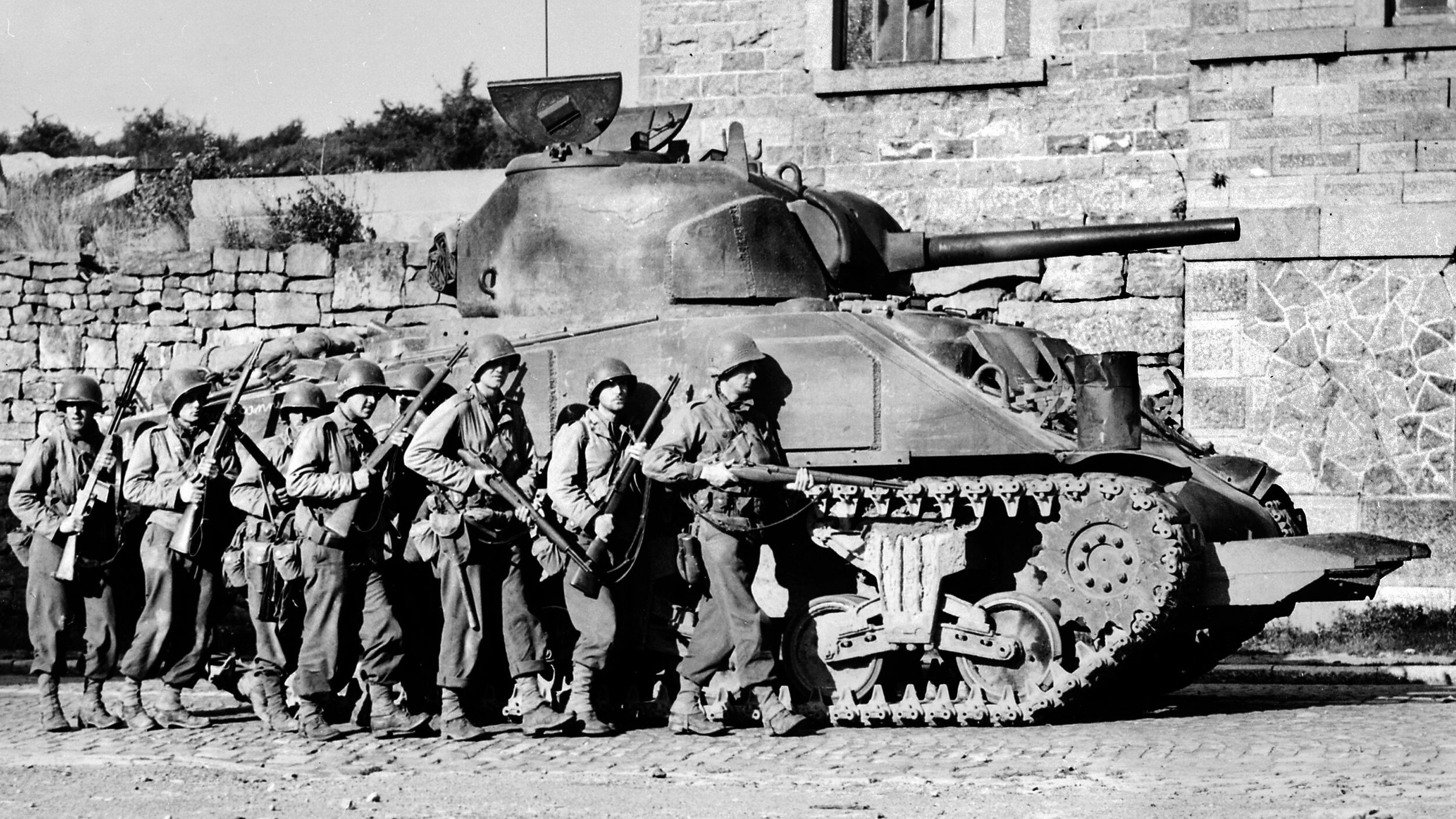
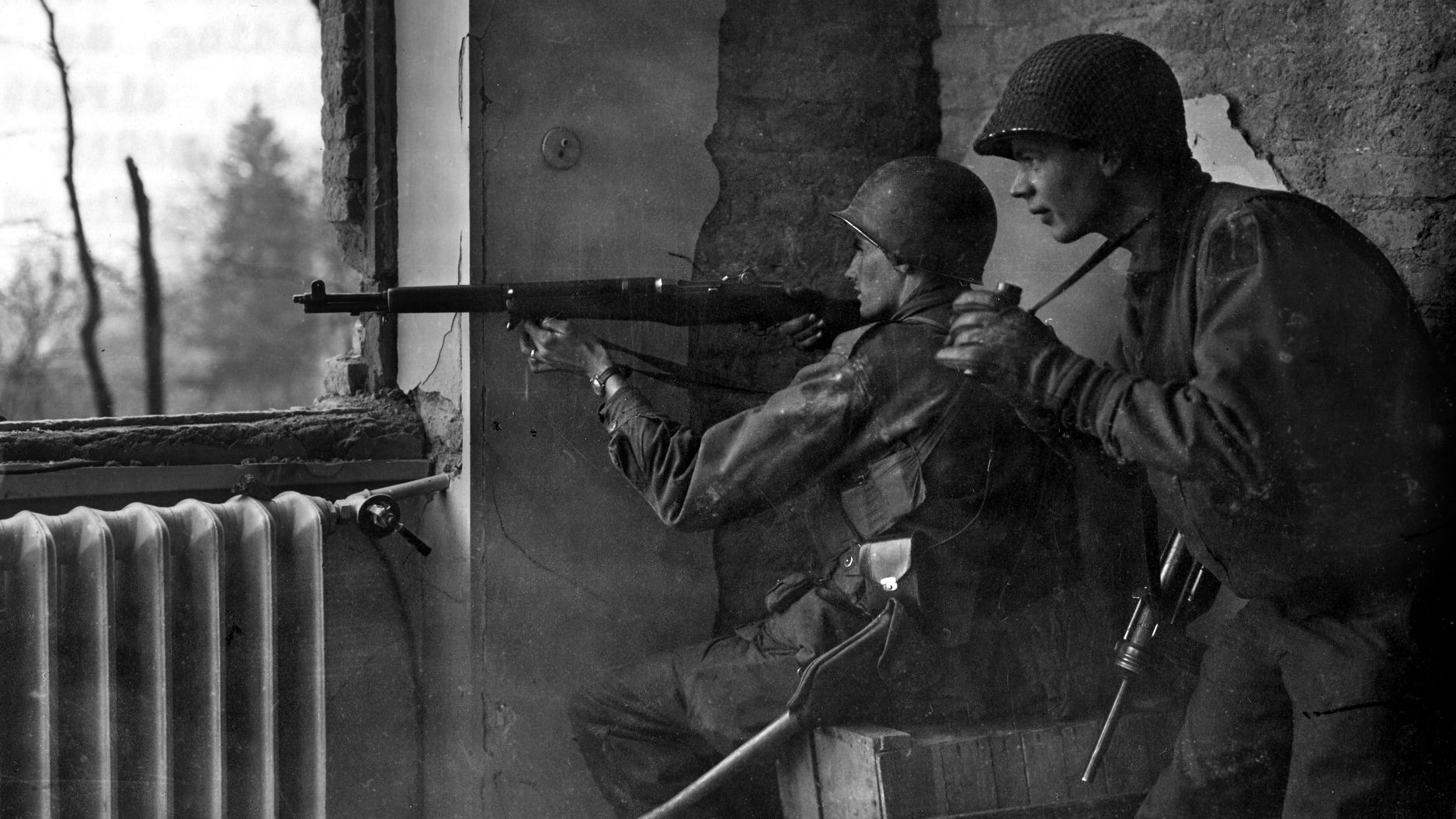
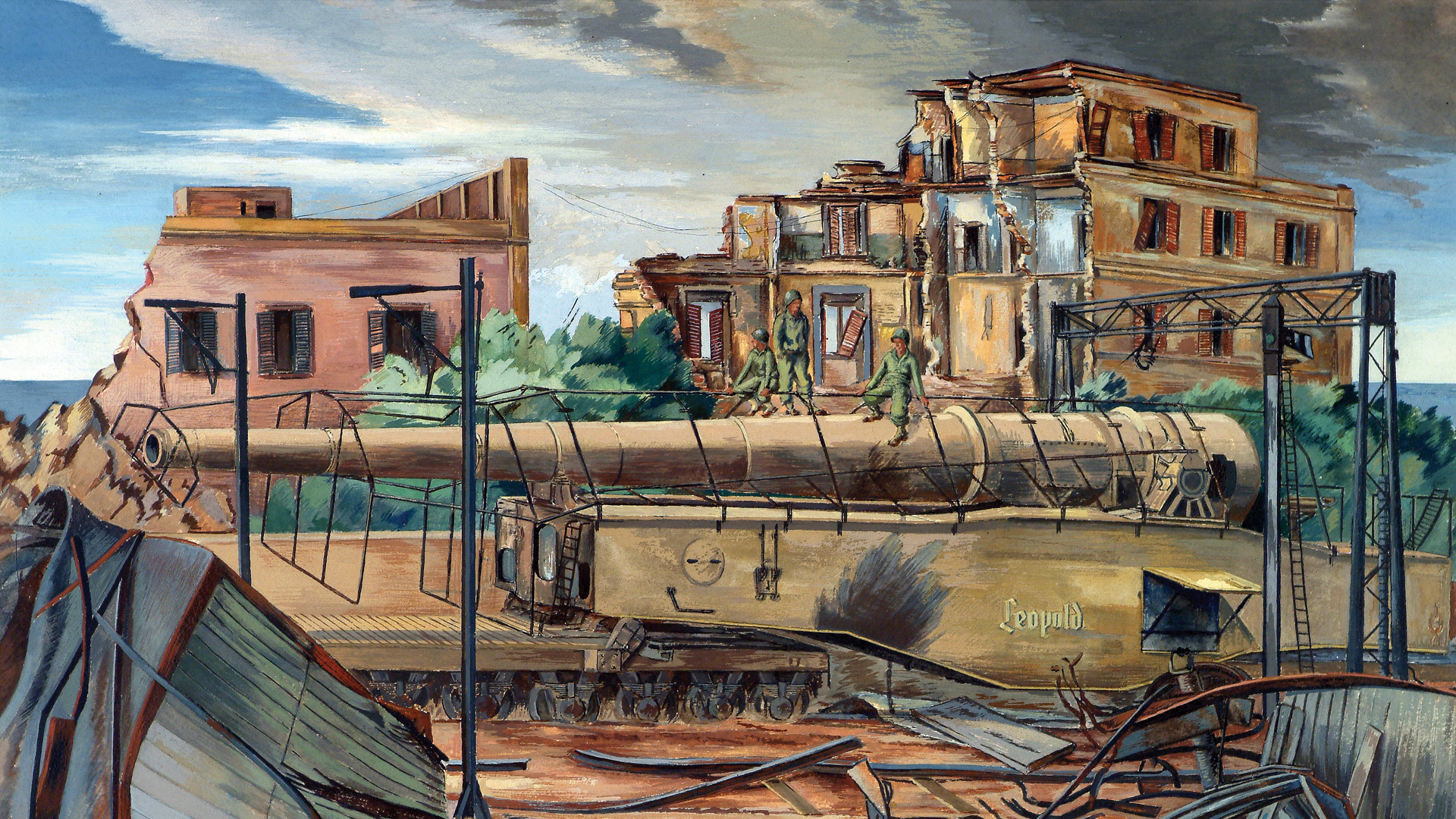
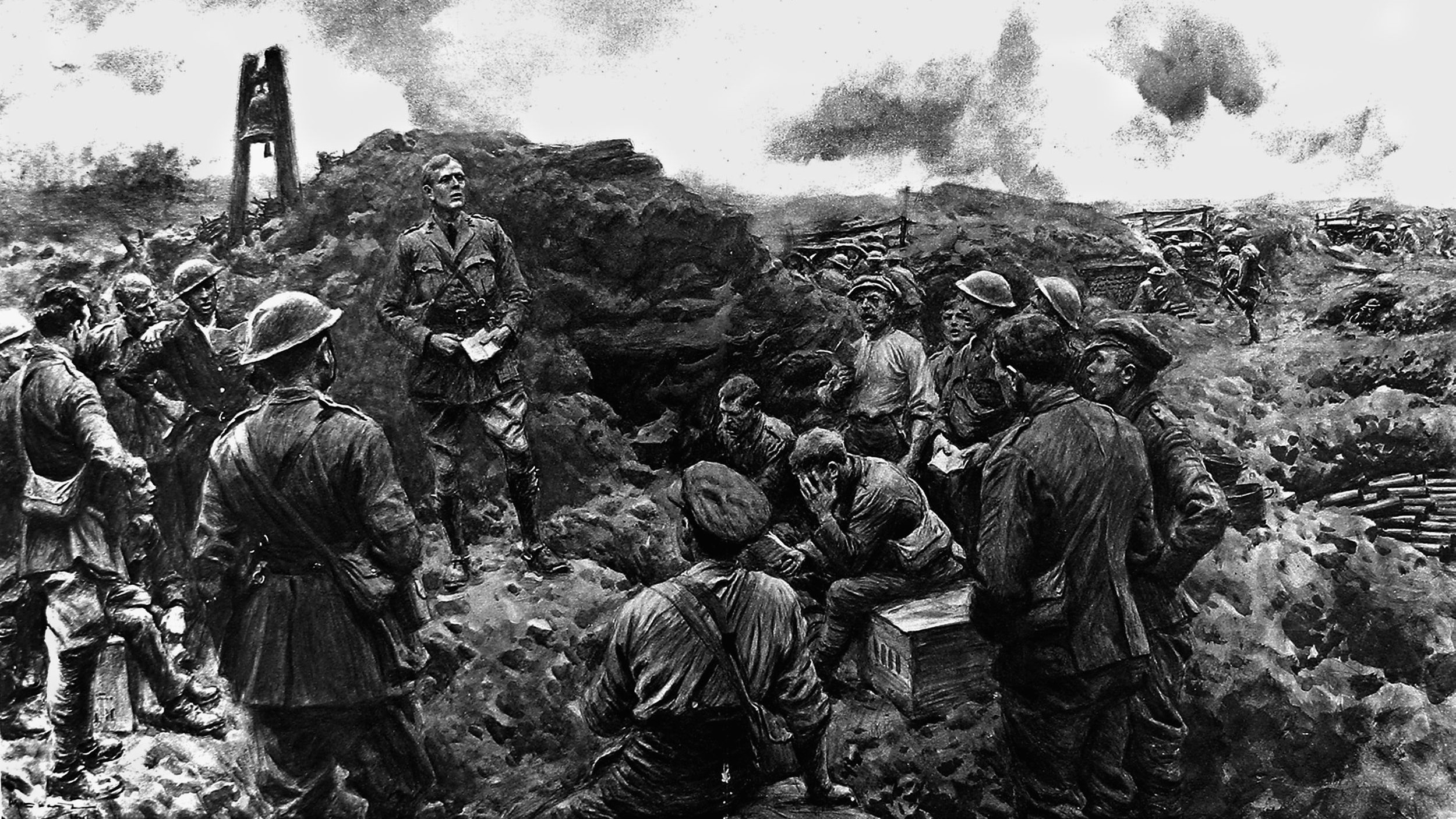
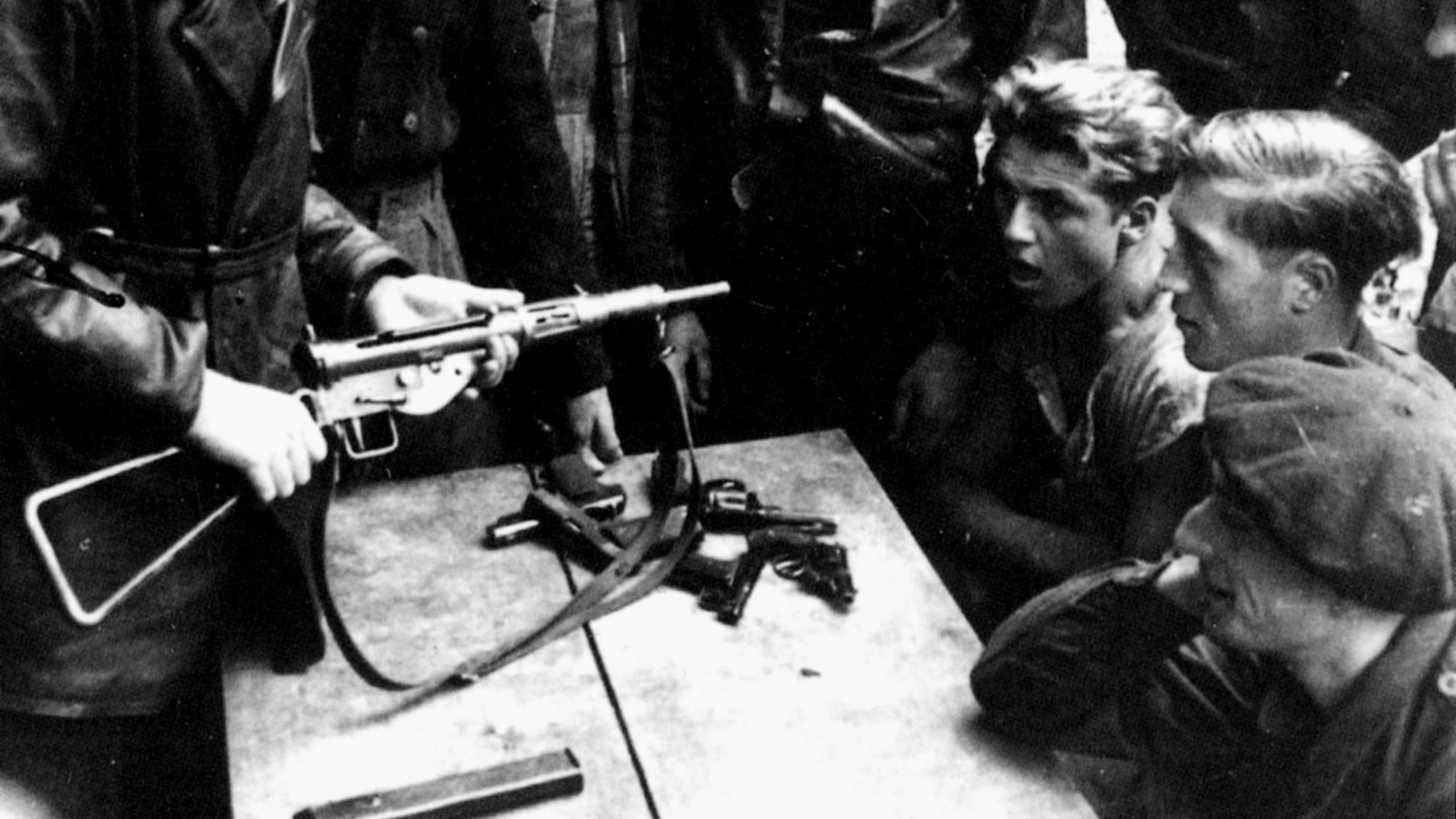
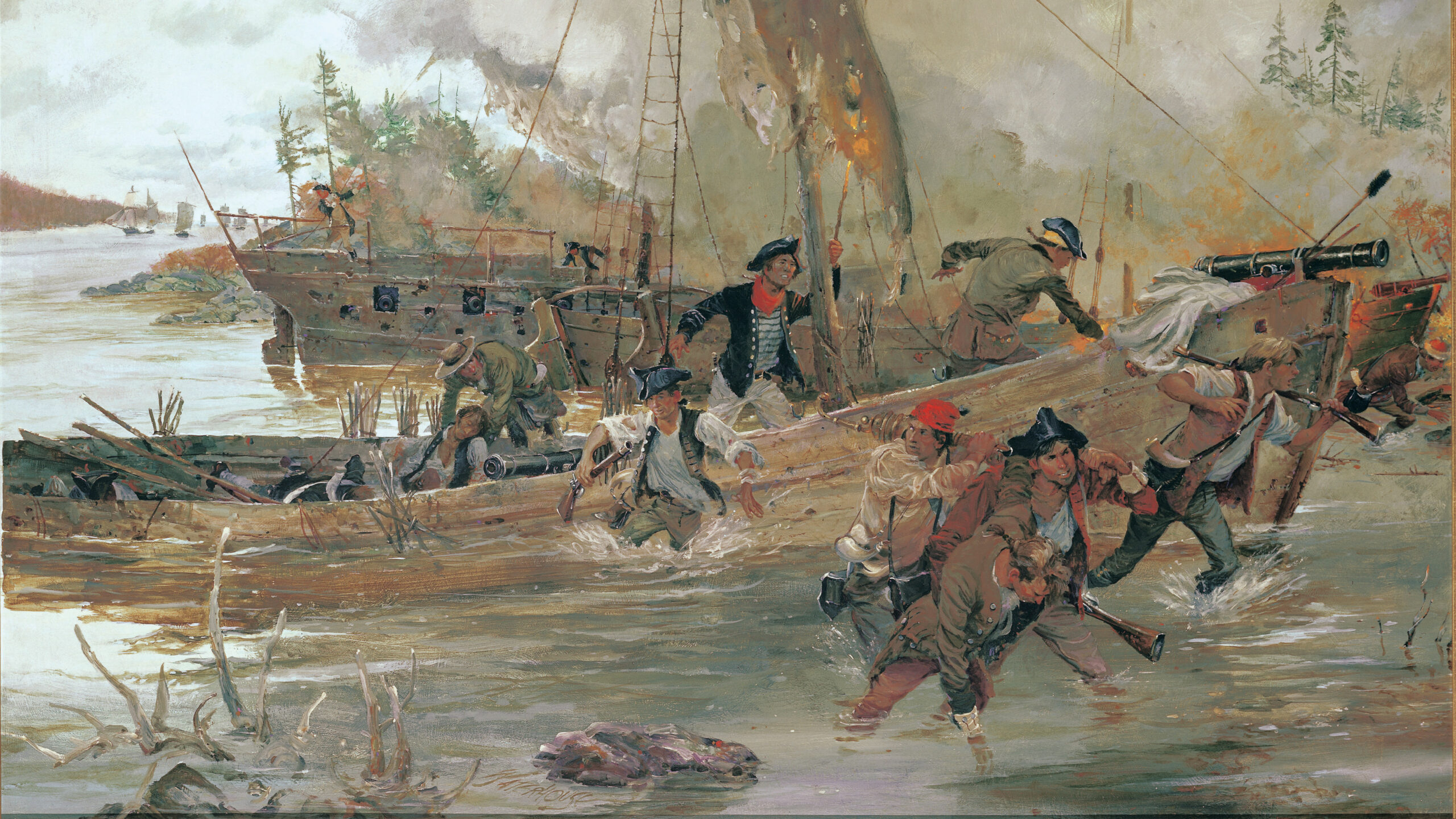
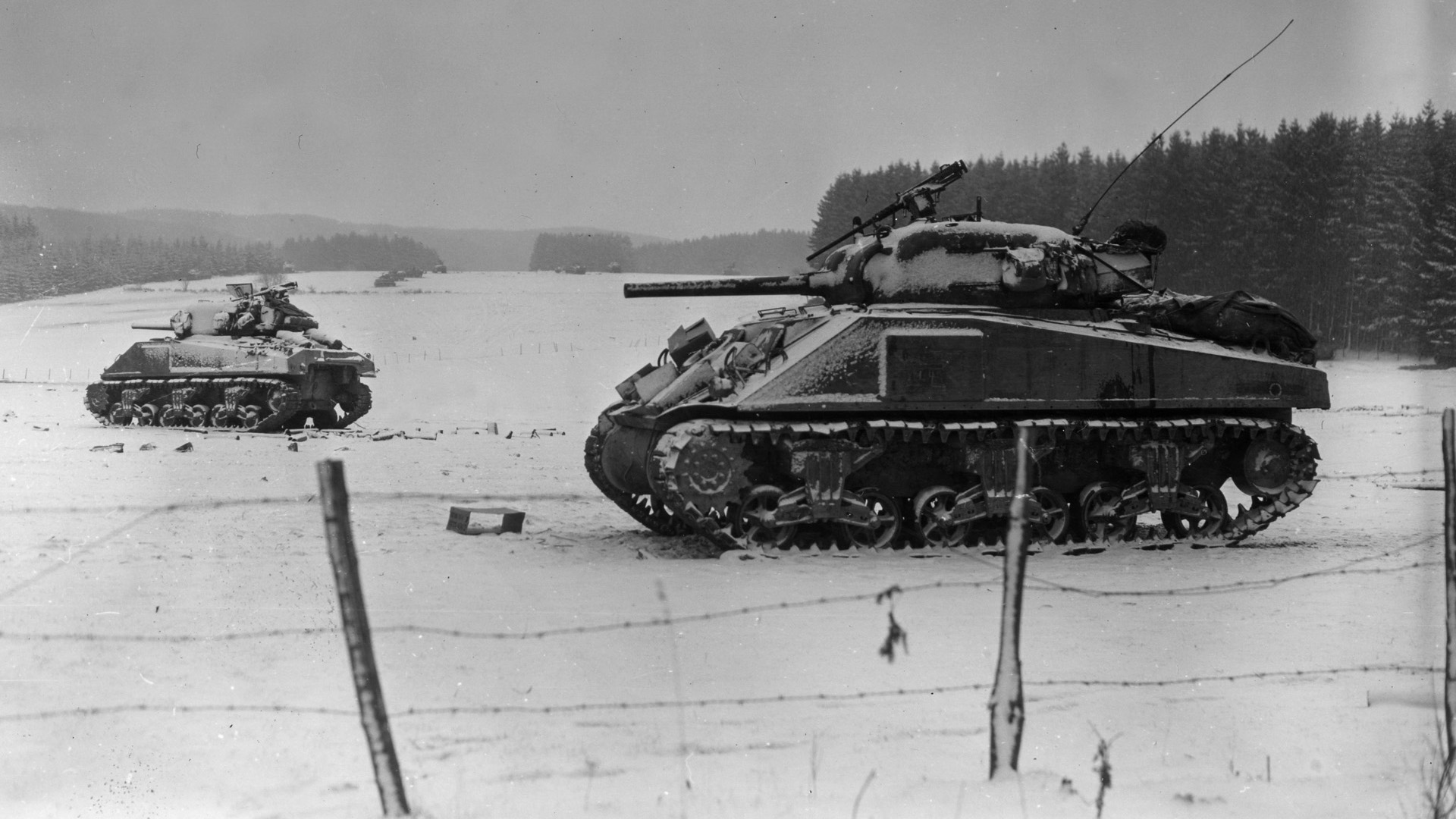
Join The Conversation
Comments
View All Comments